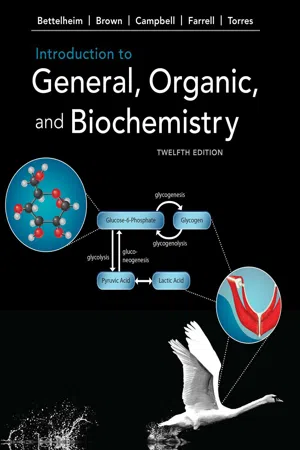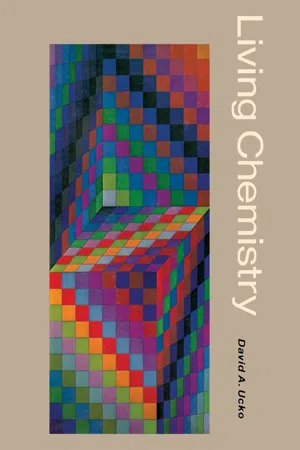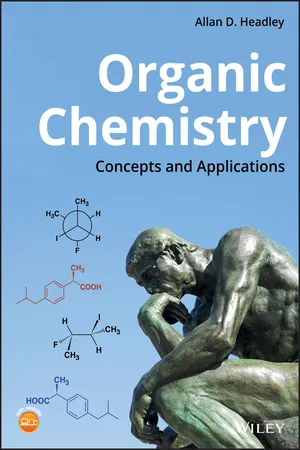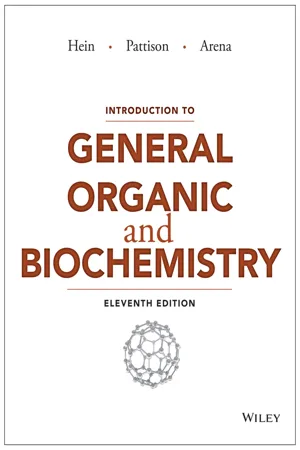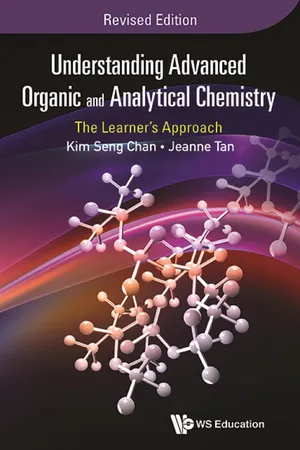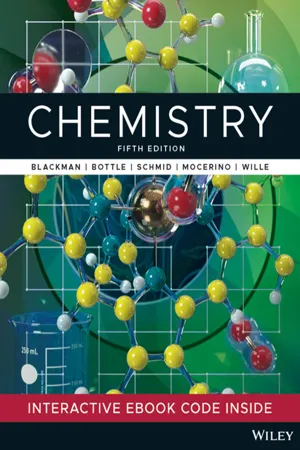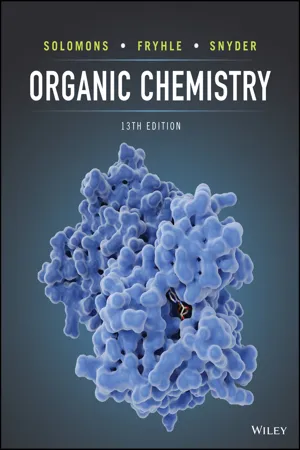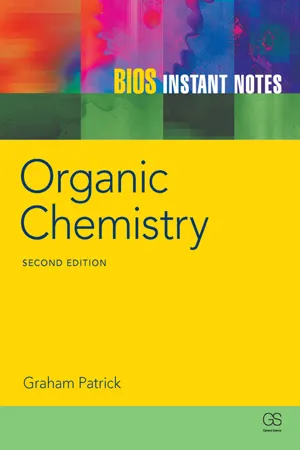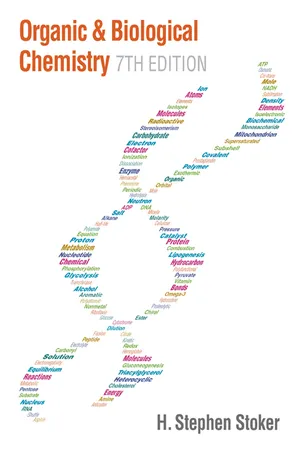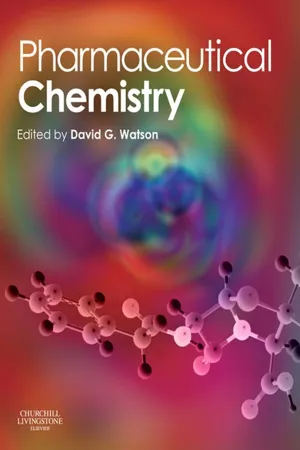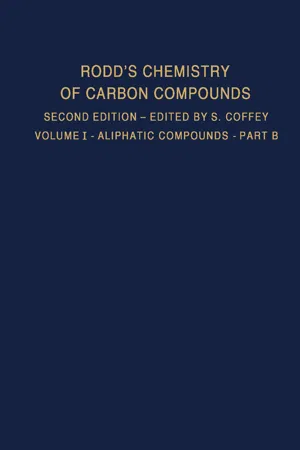Chemistry
Alcohols, Ethers and Thiols
Alcohols, ethers, and thiols are organic compounds characterized by the presence of specific functional groups. Alcohols contain a hydroxyl (-OH) group, ethers have an oxygen atom bonded to two alkyl or aryl groups, and thiols feature a sulfur atom bonded to a hydrogen atom and an alkyl or aryl group. These compounds have diverse applications in organic synthesis, pharmaceuticals, and industrial processes.
Written by Perlego with AI-assistance
Related key terms
1 of 5
12 Key excerpts on "Alcohols, Ethers and Thiols"
- Frederick Bettelheim, William Brown, Mary Campbell, Shawn Farrell(Authors)
- 2019(Publication Date)
- Cengage Learning EMEA(Publisher)
388 Alcohols, Ethers, and Thiols 13 CONTENTS 13.1 Structures, Names, and Physical Properties of Alcohols 13.2 Characteristic Reactions of Alcohols 13.3 Structures, Names, and Physical Properties of Ethers 13.4 Structures, Names, and Physical Properties of Thiols 13.5 Commercially Important Alcohols This chapter involves the study of alcohols, ethers, and thiols, and their physical and chemical properties. Alcohols and ethers are two classes of oxygen-containing organic compounds. In contrast, thiols are like alco-hols in structure, except that they contain an i SH group rather than an i OH group. These three compounds might be familiar to you. CH 3 CH 2 O H Ethanol (An alcohol) CH 3 CH 2 O CH 2 CH 3 Diethyl ether (An ether) CH 3 CH 2 S H Ethanethiol (A thiol) Ethanol is a widely used alcohol and its uses are varied. Ethanol is the fuel additive in E85 and E15, and it is also present in alcoholic beverages. Corn is fermented to produce ethanol as the fuel additive. Grapes and grains are fermented to produce wine and beer. The sugars in corn, grapes, and grains are used by the yeast to produce ethanol and carbon dioxide (CO 2 ). Diethyl ether was the first inhalation anesthetic used in general surgery. However, it is also used as a solvent in organic synthesis. Ethanethiol, like other low-molecular-weight thiols, has an irritating smell. Certain thiols are used for safety purposes because their stench is noticed at very small concentrations. Traces of ethanethiol are added to natural gas so that gas leaks can be detected by the smell of the thiol. In this chapter, you will learn about other alcohols, ethers, and thiols. These functional groups have many types of reactions and are widely observed in organic chemistry and biochemistry. Ian Shaw/Alamy Fermentation vats of wine grapes at the Beaulieu Vineyards, California. Element Colors carbon, C oxygen, O sulfur, S Copyright 2020 Cengage Learning.- eBook - PDF
- David Ucko(Author)
- 2012(Publication Date)
- Academic Press(Publisher)
Figure 11-5 is a chart containing esters and other oxygen derivatives d e -scribed in this chapter. SU T h e oxygen atom can b e c o m b i n e d with a hydrocarbon in the form of several functional groups. These groups determine to a large degree the properties o f the resulting molecule. Alcohols contain the hydroxyl group, — O H , connected to a hydrocarbon group. T h e simplest alcohol is methanol, or methyl alcohol, C H 3 O H . T h e c o m p o u n d known simply as a l c o h o l is generally ethanol, or ethyl alcohol, C H 3 C H 2 O H . R u b b i n g alcohol c o m p o u n d is 2-propanol, or isopropyl al-cohol. Other important alcohols include menthol, phenol, ethylene glycol, hexylresorcinol, and glycerol. T h e alcohol can b e converted to other oxygen-containing groups b y oxida-tion. In organic chemistry, oxidation generally involves the addition of oxygen or removal of hydrogen from a molecule. Alcohols also undergo dehydration, the removal of water. Ethers are organic molecules that contain an oxygen atom covalently b o u n d to two hydrocarbon groups. Diethyl ether, or simply ether, C H 3 -C H 2 O C H 2 C H 3 , is an important anesthetic. Other ethers include divinyl ether, eugenol, and ethylene oxide (an epoxide). Ethers are relatively stable chemically but can oxidize to form explosive peroxide compounds. Aldehydes contain a carbonyl group —c— attached to a hydrogen atom at one end and a hydrocarbon group at the other. a ter en der at es t e dr ar ns Methanal, or formaldehyde Ο H C H is the simplest aldehyde. Tests for aldehydes, using Benedict's, Fehling's, or Tollen's solution, are based on the ability of aldehydes to act as reducing agents, b e c o m i n g oxidized (to acids) in the process. Ketones have a carbonyl group attached at both ends to hydrocarbon groups, as in propanone (dimethyl ketone) or, more commonly, acetone. - eBook - ePub
Organic Chemistry
Concepts and Applications
- Allan D. Headley(Author)
- 2019(Publication Date)
- Wiley(Publisher)
COPD ).Thiols, also known as mercaptans, contain the ─SH functional group, and low molecular weight thiols, such as methanethiol, which has one carbon, have a distinct pungent, very disagreeable characteristic odor, often described as that of rotten eggs. As a result, lower molecular weights thiols are used as additive odorants to natural gas. Since natural gas in its pure form is odorless, the addition of thiols assists in the detection of natural gas, especially in situations where there are leakages. The SH functionality is also found in one of the naturally occurring amino acids, cysteine.Thiols have a common feature in that a hydrogen atom is bonded to the fairly electronegative atom, sulfur, resulting in the formation of hydrogen bonds among thiol molecules. Similar hydrogen bonds are possible for alcohols, but for alcohols, the hydrogen atom is bonded to the oxygen atom, which is more electronegative, compared to sulfur. As a result, hydrogen bonds that are formed among alcohol molecules are stronger that those formed with thiol molecules. Hence, a thiol, with a comparable molecular weight as an alcohol, has a lower boiling point than the corresponding alcohol.3.1.1 Types of Alcohols
There are a large number of alcohols. As a result, alcohols are often classified based on the type of carbon that contains the OH functionality. If the ─OH functionality is bonded to a carbon that has only one other alkyl group (R), the alcohol is classified as a primary alcohol (1°). If the ─OH is bonded to a carbon that has two alkyl groups, the alcohol is a secondary alcohol (2°), and if the ─OH group is bonded to a carbon that has three alkyl groups, the alcohol is classified as a tertiary alcohol (3°). - Morris Hein, Scott Pattison, Susan Arena, Leo R. Best(Authors)
- 2014(Publication Date)
- Wiley(Publisher)
Early in the development of organic chemistry, it was discovered that most organic molecules contain specific, especially reactive groups of atoms known as functional groups. (See Table 19.2.) A functional group brings to a molecule a select set of physical and chemical properties. Several functional groups will be discussed in this chapter, but perhaps the most important is the hydroxyl group. When a hydroxyl group is substituted for a hydrogen in an aliphatic hydrocarbon, the resulting compound is an alcohol. The hydroxyl group is one of the functional groups—one of a select few—that is especially important in biochemistry. (See Table 22.1.) Hydroxyl groups are found in a wide variety of biochemicals. Just a short list includes sugars and carbohydrates, many neurotransmitters, ste- roid hormones, important fats, and nucleic acids. As is evident from this short list, the hydroxyl group is integral to biochemistry. Why is the hydroxyl group so useful? The answer to this question lies with the physical and chemical properties of this functional group. The structures of alcohols, ethers, and phenols may be derived from the structure of water by replacing the hydrogen atoms of water with alkyl groups (R) or aromatic rings: O phenol H O ether R R O alcohol H R O water H H The R i groups in ethers can be the same or different and can be alkyl groups or aromatic rings. Structurally, an alcohol is derived from an aliphatic hydrocarbon by the replacement of at least one hydrogen atom with a hydroxyl group ( i OH). Alcohols are represented by the general formula ROH, with methanol (CH 3 OH) being the first member of the homologous series. (R represents an alkyl or substituted alkyl group.) Models illustrating the structural arrangements of the atoms in methanol and ethanol are shown in Figure 22.1.- eBook - ePub
Understanding Advanced Organic and Analytical Chemistry
The Learner's ApproachRevised Edition
- Kim Seng Chan, Jeanne Tan;;;(Authors)
- 2016(Publication Date)
- WS EDUCATION(Publisher)
2n+2 ? This is because the O atom in both alcohol and ether serves a bridging purpose between two atoms.Q:Does the replacing carbon atom need to be always a sp3 hybridized carbon atom?A:No, it is not necessary. If the replacing carbon atom is a sp2 hybridized carbon atom, we would get classes of compound known as phenol and carboxylic acid. Subsequently, we will be looking at these two compounds in the book.8.2 Nomenclature
Alcohols are named with the suffix–ol. Other substituents are named as prefixes accompanied by the appropriate positional numbers. If the hydroxyl group is considered a substituent, then it is named as the — hydroxy prefix (notice that the prefix is not “hydroxyl”).Alcohols can also be classified as primary (1°), secondary (2°) or tertiary (3°) alcohols, as shown below:Phenol is a special name given to the benzene derivative that contains the hydroxyl group directly attached to the benzene ring. Note that all the carbon atoms in the ring are sp2 hybridized. For substituted phenols, the substituents are named as prefixes accompanied by positional numbers. The carbon atom with the −OH group is numbered as carbon 1. For example:8.3 Physical Properties
8.3.1 Melting and Boiling Points
Melting and boiling points increase with increasing carbon chain length and decrease with an increase in the degree of branching. The trend can be accounted for by the differential strength of the instantaneous dipole–induced dipole (id–id) attractive forces arising due to the increase in the number of electrons that accompanies the increasing carbon chain length, rather than due to hydrogen bonding. - eBook - PDF
- Allan Blackman, Steven E. Bottle, Siegbert Schmid, Mauro Mocerino, Uta Wille(Authors)
- 2022(Publication Date)
- Wiley(Publisher)
Epoxides are highly strained cyclic ethers which readily undergo ring-opening reactions to relieve the ring strain. This can occur when epoxides are subjected to strong nucleophiles or under acid-catalysed conditions. For example, treatment of ethylene oxide with aqueous sodium hydroxide will produce the diol ethylene glycol. Treatment of epoxides in aqueous acid will lead to the same product. O OH HO – OH H 2 O O OH HO H 3 O + H 2 O When epoxides are treated with alcohols under acidic conditions a hydroxy ether is produced. O OH RO ROH acid 19.5 Thiols LEARNING OBJECTIVE 19.5 Describe the functional group, nomenclature, physical properties and reactions of thiols. The sulfur analogue of an alcohol is called a thiol (thi- from the Greek: theion, sulfur) or, in the older literature, a mercaptan, which literally means ‘mercury capturing’. Since sulfur and oxygen belong to the same group of the periodic table, they share similar chemical properties. Thiols form thioesters, thioethers and thioacetals in the same way alcohols form esters, ethers and acetals (see the chapter on aldehydes and ketones). The functional group of a thiol is an SH (sulfhydryl) group. Figure 19.14 shows a Lewis structure and a ball-and-stick model of methanethiol, CH 3 SH, the simplest thiol. The electronegativities of carbon and sulfur in methanethiol are virtually identical (2.55 and 2.58 Pdf_Folio:979 CHAPTER 19 Alcohols, amines and related compounds 979 respectively), while sulfur is slightly more electronegative than hydrogen (2.58 versus 2.20). The electron density model shows some slight partial positive charge on hydrogen atom of the SH group and some slight partial negative charge on the sulfur atom. FIGURE 19.14 Methanethiol, CH 3 SH: (a) Lewis structure, (b) ball-and-stick model and (c) electron density model H C H H H S (a) (b) (c) In the IUPAC system, thiols are named in the same way as alcohols, except that the ending -thiol is added to the name of the parent alkane. - eBook - PDF
- T. W. Graham Solomons, Craig B. Fryhle, Scott A. Snyder(Authors)
- 2022(Publication Date)
- Wiley(Publisher)
Allylic OH 2-Propenol (or prop-2-en-1-ol, or allyl alcohol), an allylic alcohol Benzyl alcohol, a benzylic alcohol OH Benzylic Compounds that have a hydroxyl group attached directly to a benzene ring are called phenols. H 3 C OH Phenol p-Methylphenol, a substituted phenol General formula for a phenol OH Ar OH IN THIS CHAPTER WE WILL CONSIDER: • the structures, properties, and nomenclature of common alcohols and ethers • key molecules that contain such groups • the reactivity of alcohols, ethers, and a special group of ethers known as epoxides WHY DO THESE TOPICS MATTER? At the end of the chapter, we will see how the reactivity of epoxides can not only make highly complex molecules containing dozens of rings from acyclic precursors in a single step, but also help detoxify cancer-causing compounds from grilled meat, cigarettes, and peanuts. See the online course materials in for additional examples, videos, and practice. 498 CHAPTER 11 Alcohols and Ethers Ethers differ from alcohols in that the oxygen atom of an ether is bonded to two carbon atoms. The hydrocarbon groups may be alkyl, alkenyl, vinyl, alkynyl, or aryl. Several examples are shown here: tert-Butyl methyl ether OCH 3 Allyl methyl ether OCH 3 Methyl phenyl ether OCH 3 Divinyl ether O Diethyl ether O 11.1A Nomenclature of Alcohols We studied the IUPAC system of nomenclature for alcohols in Sections 2.6 and 4.3F. As a review, consider the following problem. • The hydroxyl group has precedence over double bonds and triple bonds in deciding which functional group to name as the suffix [see example (c) above]. In common functional class nomenclature (Section 2.6) alcohols are called alkyl alcohols such as methyl alcohol, ethyl alcohol, and so on. 11.1B Nomenclature of Ethers Simple ethers are frequently given common functional class names. - eBook - ePub
- Graham Patrick(Author)
- 2004(Publication Date)
- Taylor & Francis(Publisher)
Thiols form extremely weak hydrogen bonds — much weaker than alcohols — and so thiols have boiling points which are similar to comparable thioethers and which are lower than comparable alcohols. For example, ethanethiol boils at 37°C whereas ethanol boils at 78°C.Low molecular weight thiols are notorious for having disagreeable aromas.Reactivity
Thiols are the sulfur equivalent of alcohols (RSH). The sulfur atom is larger and more polarizable than oxygen which means that sulfur compounds as a whole are more powerful nucleophiles than the corresponding oxygen compounds. Thiolate ions (e.g. CH3 CH2 S− ) are stronger nucleophiles and weaker bases than corresponding alkoxides (CH3 CH2 O− ). Conversely thiols are stronger acids than corresponding alcohols.The relative size difference between sulfur and oxygen also means that sulfur' s bonding orbitals are more diffuse than oxygen' s bonding orbitals. This results in a poorer bonding interaction between sulfur and hydrogen, than between oxygen and hydrogen. As a result, the S–H bond of thiols is weaker than the O–H bond of alcohols (80 kcal mol−1 vs. 100 kcal mol−1 ). This in turn means that the S–H bond of thiols is more prone to oxidation than the O–H bond of alcohols.Reactions
Thiols are easily oxidized by mild oxidizing agents such as bromine or iodine to give disulfides (Figure 2 ).Thiols react with base to form thiolate ions which can act as powerful nucleophiles (Section L6 ; Figure 3 ).Figure 2. Oxidation of thiols. Figure 3. Formation of thiolate ions. - eBook - PDF
- H. Stephen Stoker(Author)
- 2015(Publication Date)
- Cengage Learning EMEA(Publisher)
Cengage Learning reserves the right to remove additional content at any time if subsequent rights restrictions require it. 96 CHAPTER 3 Alcohols, Phenols, and Ethers Although all alcohols are able to participate in hydrogen bonding (Section 3-6), increasing the number of R groups around the carbon atom bearing the OH group decreases the extent of hydrogen bonding. This effect, called steric hindrance, becomes particularly important when the R groups are large. Thus, 1° alcohols are best able to hydrogen-bond and 3° alcohols are least able to hydrogen-bond. For alcohols of similar molecular mass, 1° alcohols have higher boiling points than 2° alcohols, which in turn have higher boiling points than 3° alcohols, because of how steric hindrance affects hydrogen bonding. The following data for three C 4 alcohols illustrates this situation. 3 8 alcohol b.p. = 83 8 C 2 8 alcohol b.p. = 98 8 C 1 8 alcohol b.p. = 118 8 C CH 3 O CH 2 O CH O OH CH 3 O CH 2 O CH 2 O CH 2 O OH A CH 3 CH 3 CH 3 CH 3 C O OH O A A Classifying Alcohols as Primary, Secondary, or Tertiary Alcohols Classify each of the following alcohols as a primary, secondary, or tertiary alcohol. CH 3 O CH 2 O CH 2 O OH CH 3 CH 3 A A a. CH 3 O CH 2 O C O OH b. OH OH CH 3 A A CH 3 A CH 3 O CH O CH O CH O CH 3 c. d. Solution a. This is a primary alcohol. The carbon atom to which the — OH group is attached is bonded to only one other carbon atom. b. This is a tertiary alcohol. The carbon atom bearing the — OH group is bonded to three other carbon atoms. c. This is a secondary alcohol. The hydroxyl-bearing carbon atom is bonded to two other carbon atoms. d. This is a secondary alcohol. The ring carbon atom to which the — OH group is attached is bonded to two other ring carbon atoms. - eBook - ePub
- David G. Watson(Author)
- 2011(Publication Date)
- Churchill Livingstone(Publisher)
This is really a generalisation, it is probably truer to say that where oxygen-containing groups play an important role in conferring pharmacological activity they have a very specifically targeted function. In contrast, the charged nitrogen atom exerts a more general effect and may affect a number of targets. This theme will be expanded later in the chapter. Water is the fundamental oxygen-containing biologically active substance and some of its unique properties have been discussed in Chapter 1. The 3-D structure of water is shown in Figure 5.1. The geometry is more or less tetrahedral with the lone pairs occupying two of the corners of the tetrahedron and the two protons the other two. The lone pairs in water lie in a deeper energy well (highest occupied molecular orbital [HOMO] −12.4 eV) than the lone pair in ammonia (HOMO −10.4 eV). In the case of ethanol, the energy well occupied by the most accessible lone pair is slightly shallower at −11.2 eV, indicating that alcohols are slightly more basic than water and conversely water is a stronger acid than alcohols. Water can function both as a weak acid and a weak base as indicated in Figure 5.2. Figure 5.1 3-D structure of water and ethanol. Figure 5.2 Ionisation of water. Monohydric alcohols The lower alcohols are liquids with low boiling points. Methanol, ethanol and propanol are all miscible with water but n-butanol is only soluble 1 part in 10 in water and amyl alcohol is immiscible with water. If the surface area of the hydrocarbon chain of the alcohol is decreased, then water solubility will increase. Thus the order of water solubility for the primary, secondary and tertiary butyl alcohols is: t-butanol > butanol-2-ol > n-butanol (Fig. 5.3); t-butanol is freely soluble in water. The properties of some alcohols are shown in Table 5.1. Figure 5.3 Primary, secondary and tertiary alcohols. Table 5.1 Some monohydric alcohols Formula Name b.p - eBook - PDF
Monohydric Alcohols Their Ethers and Esters Sulphur Analogues Nitrogen Derivatives Organometallic Compounds
A Modern Comprehensive Treatise
- S. Coffey(Author)
- 2016(Publication Date)
- Elsevier(Publisher)
Chapter 5 Sulphur Analogues of the Alcohols and their Derivatives H. G O L D W H I T E Although a number of classes of sulphur compounds, including the thiols, the sulphides, and the disulphides, are formally analogous to oxygenated compounds, the chemistry of the two series shows more differences than similarities. The ease with which sulphur, an element in the second row of the Periodic Table, can attain the higher oxidation numbers +4 and +6, means that series of stable sulphur compounds exist which have no oxygen analogues. The hypothetical relationships which exist between these various types of compounds may be indicated as follows : R-SH [ 0 ] > R-S-OH [ 0 ] > R.SO-OH E ° 3 > R.S0 2 -OH Thiol Sulphenic Sulphinic Sulphonic acid acid acid R-S-R' L J > R-SO.R' L J > R.S0 2 -R' Sulphide Sulphoxide Sulphone This chapter deals with the chemistry of these and related sulphur com-pounds, viz. : disulphides, polysulphides, sulphonium compounds, alkylthiol-sulphonic acids and alkanethiosulphonic acids. Those selenium and tellurium analogues which exist are dealt with in Chapter VII. A recent general review of preparative sulphur chemistry appears in Houben-Weyl, Methoden der Organischen Chemie, Vol. IX, Georg Thieme Verlag, Stuttgart, 1955. A number of chapters in 'Organic Sulphur Com-pounds, Vol. I, Ed. N. Kharasch, Pergamon Press, Oxford, 1961, are of general interest for the whole area of sulphur chemistry. These include chapters on the thermodynamics of organic sulphur compounds; on the 74 SULPHUR ANALOGUES OF THE ALCOHOLS 5 bonding characteristics of the sulphur atom; and on infrared and ultraviolet absorption spectra of organic sulphur compounds. Other theoretical aspects of organic sulphur chemistry are discussed by C. C. Price and 5. Oae in Sulphur Bonding, Ronald Press Co., New York, 1962, and by W. A. Pry er in Mechanisms of Sulphur Reactions, McGraw-Hill, New York, 1962. A comprehensive discussion of thiols, sulphides, sulphenic acid derivatives, etc. - eBook - PDF
Aliphatic Compounds
A Modern Comprehensive Treatise
- S. Coffey(Author)
- 2016(Publication Date)
- Elsevier(Publisher)
Other theoretical aspects of organic sulphur chemistry are discussed by C. C. Price and S. Oae in Sulphur Bonding, Ronald Press Co., New York, 1962, and by W. A. Pry er in Mechanisms of Sulphur Reactions, McGraw-Hill, New York, 1962. A comprehensive discussion of thiols, sulphides, sulphenic acid derivatives, etc. is given by E. E. Reid in 'Organic Chemistry of Bivalent Sulphur, Chemical Publishing Co., New York, i960. The natural occurrence of sulphur compounds is reviewed by A, I. Virtanen, Angew. Chem. Internat. Edn., 1962, 1, 199. 1. Thiols, mercaptans, or alkyl hydrosulphides The thiols, RSH, are the sulphur analogues of the alcohols. Their structure follows from the mode of synthesis from alkyl halides and alkali-metal hydrosulphides, and is confirmed by the reactions of the class. Ethanethiol (ethyl mercaptan) was the first member of the class to be discovered and investigated (W. C. Zeise, Ann., 1834, Ιτ > x )> a n ( i a wide variety of thiols has been prepared. These compounds were originally called mercaptans (Lat. mercurmm aptans) because of their ready reaction with mercuric oxide to form crystal-line mercury derivatives : 2 C 2 H 5 SH + HgO ► (C 2 H 5 S) 2 Hg + H 2 0 The I.U.P.A.C. system of nomenclature uses the suffix thiol appended to the name of the hydrocarbon from which the compound is derived. The metal derivatives of the thiols are usually called mercaptides. Occurrence. Free thiols rarely occur in natural products. Methanethiol is found in the radish (N. Nakamura, Biochem. Z., 1925, 164, 31) and the skunk employs i-butanethiol as a defensive weapon (see S. Blackburn and F. Challenger, J. chem. Soc, 1938, 1872, for reference to this and other natural sources of thiols). Some natural gases contain considerable amounts of methanethiol and ethanethiol, and large amounts of the lower alkane-thiols are produced in the thermal cracking of crude petroleum oils.
Index pages curate the most relevant extracts from our library of academic textbooks. They’ve been created using an in-house natural language model (NLM), each adding context and meaning to key research topics.
